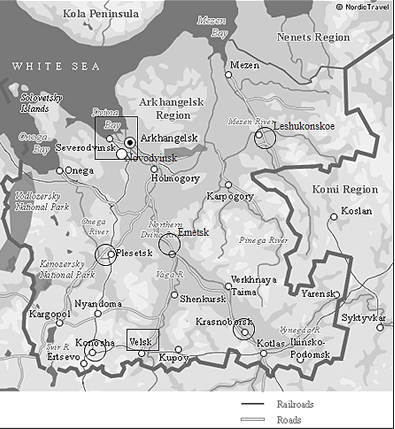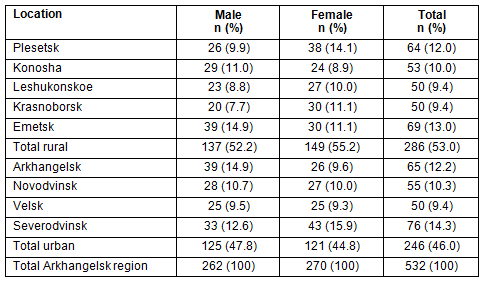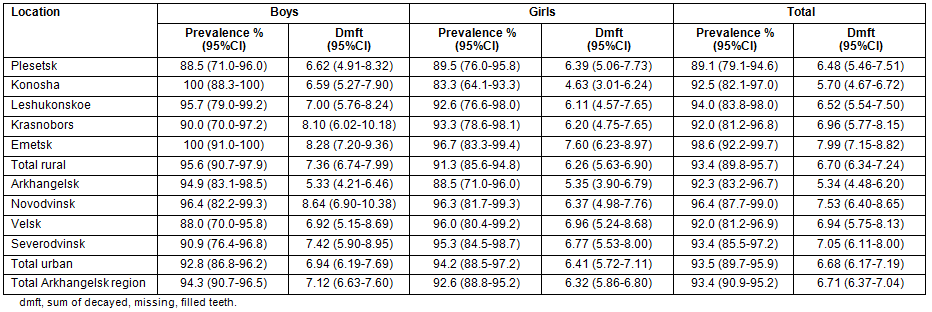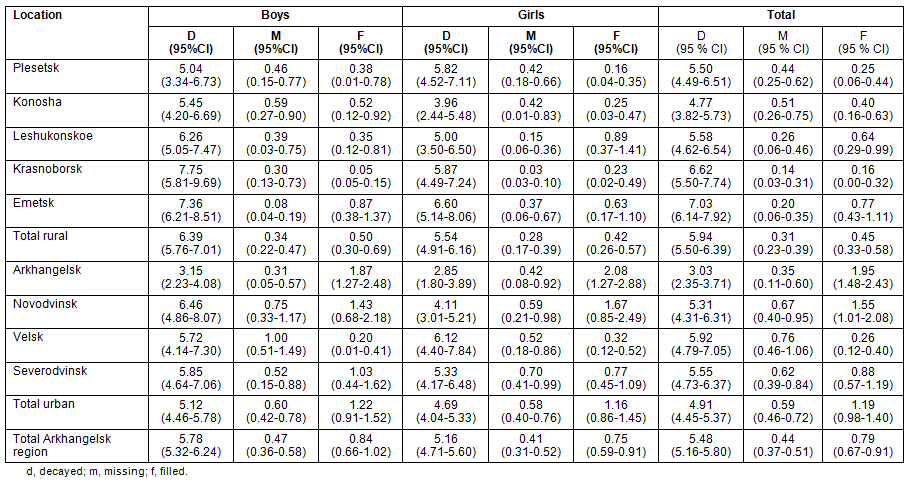Children at the age of 6 years represent a key group recommended by the WHO for assessing caries of the primary teeth1. Although the global prevalence of caries among 6-year-old children is decreasing, it remains a major public health problem with a considerable variation among countries2. While the prevalence of caries among 6-year-olds was 32% in Spain, 46.9% in Portugal and 49% in Austria3-5, the corresponding proportions for Turkey, China, India and Ecuador were 77%, 78%, 81% and 87%, respectively6-9. In European countries caries experience expressed as a sum of decayed, missing, filled teeth (dmft index) for the 6-year-olds varied from less than 2 affected teeth per child in Norway, Finland and Switzerland to 4.7 in Belarus10; while in China, the dmft level of 4.5 was observed in the same age group11.
The latest nationally representative Russian oral health survey was performed in period 1996-1998 and showed that the prevalence of caries in primary dentition among 6-year-old children was 73%12. The mean dmft was 4.8 with decayed teeth (dt) being a predominant component (dt 3.5, mt = 0.1, ft = 1.2).
People who live in remote northern areas of Russia have been reported consistently to have poorer health in general and lower life expectancy compared to the national average13,14. Moreover, rural residents, particularly in the north, have greater overall mortality and morbidity than their urban counterparts15. According to the results of the oral health survey performed in the Arkhangelsk region, one of the northernmost regions of Russia, in the period 1996-1998 this is also applicable to oral health: the overall prevalence of caries among 6-years-old children in the region was 95% with the mean dmft value of 5.4 exceeding the national average of 73%12,16. No adequate information about caries prevalence and experience among children is currently available from the region, particularly its rural areas which suffer poor availability of and accessibility to dental health services. At the same time public dental health is among the least prioritized areas of public health in northern areas.
The development of teeth begins in intrauterine life and many oral health problems in children are attributed to the general health of their mothers and the course of pregnancy17. Pregnancy disorders have been shown to be associated with impairment of the enamel during a child's antenatal period18,19. Furthermore, preterm birth, low birth weight and infections in infancy are also associated with poor oral health in children20,21. A recent report has shown that the health of women in Russia in general and in the Arkhangelsk region in particular has worsened during the time of transition from Socialism to market economy, and that the incidence of pregnancy complications has increased13. Thus, one may hypothesize that poorer maternal health combined with non-existent dental health preventive programs have resulted in a further increase in the prevalence of caries among children in the region.
This study aimed to estimate the prevalence and experience of dental caries among 6-year-old children in the Arkhangelsk region to provide a foundation for the development of preventive measures in the north of Russia.
The study is a part of the Russian National Dental Health Survey22. The Arkhangelsk region is situated in Northwest Russia and covers a territory of 413 100 km². The population of 1.26 million in 2008 gives the population density of 3 per km² making the region of the most sparsely populated in the country with considerable distances between towns and villages13. The number of 6-year-old children in 2008 was 13 203 (6746 boys) with 74.5% living in towns23. There are no areas with water fluoridation in the region.
Participants were recruited in 5 randomly selected rural settings (Emetsk, Plesetsk, Konosha, Leshukonskoe and Krasnoborsk) and 4 urban settings (Arkhangelsk, Severodvinsk, Novodvinsk and Velsk) of the Arkhangelsk region. Altogether, there are 13 towns and 20 rural districts in the region so the study includes 30% of the towns and 20% of the rural districts. Arkhangelsk, Novodvinsk, Severodvinsk and Leshukonskoe are situated in the northern area and two areas (Emetsk and Plesetsk) are in the central part. All other settings are located in the southern area of the region (Fig1).

Figure 1: Map of the Arkhangelsk region, Northwest Russia. Urban and rural
areas included in the study are shown as squares and circles, respectively.
Virtually all Russian children attend kindergarten at the age of 6 years. At least 50 children from each location were recruited according to WHO recommendations1, comprising approximately 3% of all 6-year-old children in the region. More detail of the sampling procedure is available elsewhere24. Usually, there are 1 or 2 kindergartens in rural areas of the region. Therefore, almost all 6-year-old children in the selected rural areas were included in the study. In each of the urban areas, kindergartens were randomly selected to ensure representativeness of the sample. The overall sample size was 532 children (50.8% girls).
Table 1: Sample composition by location and sex

All study participants underwent a clinical dental examination in the selected kindergartens in the areas assigned for this purpose. Clinical criteria for dental caries as defined by WHO were applied1. All examinations were performed by a single trained and calibrated dentist (the first author). Special calibration of practical skills was performed at the Moscow State Medical University of Dentistry in 2007. A written permit to conduct this type of examination for research purposes in accordance with the WHO recommendations was obtained to ensure comparability of the results with similar studies and reduce measurement bias. The examination was performed with the child sitting on a chair and the examiner standing or sitting in front of the child. A trained assistant completed registration cards. The average duration of dental examination was 10 min. After each hour of the examination session a 15-20 min break was scheduled to avoid the effects of visual fatigue.
The examination was carried out with a WHO-type periodontal probe and plain mouth mirror. No radiographs were taken. Children at the age of 6 are the index age group of the WHO in assessing dental caries in primary teeth, therefore only primary teeth were taken into consideration. Caries prevalence was calculated as a number of children with at least one affected tooth (decayed or missing or filled) divided by all examined children in the sample and multiplied by 100%. Caries experience was expressed as a sum of decayed, missing, filled teeth (dmft index). Teeth that could be absent because of natural teeth change were not taken into consideration in assessing the missing component. Dental caries was detected visually at the cavitation level (D3-level). The study was conducted from November 2007 to December 2008.
Statistical analysis
Dmft index scores were calculated for primary teeth for each child. For the dmft index, teeth that had been extracted due to trauma, or were absent from birth were excluded and they did not contribute to the final score. The prevalence of dental caries in primary teeth was calculated for each setting as well as for all rural and for all urban areas and for the full sample. Ninety-five percent confidence intervals (CI) were calculated using the Wilson's method25. Mean dmft index with 95% CI was calculated for each location as recommended by the WHO1. Differences in the prevalence of caries between districts were analyzed by Pearson's χ2 tests. Because of the skewed distribution of the data, the differences in dmft and every component of the index between children who lived in rural and urban areas as well as sex differences were analyzed using Mann-Whitney tests while the differences in caries experience between the 9 settings were calculated by Kruskal-Wallis tests. When statistically significant differences by this test were found, post-hoc comparisons were performed using Mann-Whitney tests with Bonferroni correction with critical level of significance of 0.001 to compensate for type I error inflation due to multiple comparisons26. All analyses were performed using SPSS v16.0 (www.spss.com).
Directors of all selected kindergartens were informed about the aims of the study in advance and agreements with the investigators were obtained based on the Edict No. 394 of The Ministry of Health and Social Development of the Russian Federation22. A written informed consent was obtained from all parents. Children who refused to participate in the study were replaced by other children from the same kindergartens. There were no more than 2 refusals in any of the settings. The study was approved by the ethical committee of the Northern State Medical University.
The overall prevalence of caries in primary teeth was 93.4% (95%CI: 90.9-95.2). The prevalence of caries varied between 89.1% in Plesetsk and 98.6% in Emetsk (Table 2). The differences between settings did not reach the level of statistical significance (χ²(8) = 6.275, p=0.625). The overall prevalence of caries in rural and urban areas was also similar (χ²(1) = 0.004, p=0.948). No sex differences in any of the settings or in the full sample (χ²(1) = 0.612, p=0.434) were observed.
The overall mean dmft was 6.71 (95%CI: 6.37-7.04). Although the statistically significant differences between the settings by Kruskal-Wallis test were found, post-hoc comparisons between all settings showed that the dmft index reached the critical level of significance of 0.001 only between the rural Emetsk district and the regional capital Arkhangelsk (p<0.001), and Konosha (p=0.001). Detailed information on the dmft index is presented (Table 2). There were no differences in the overall caries experience between rural and urban areas (p=0.742). On average there were significantly more affected teeth in boys (7.12 vs 6.32, p=0.023) than in girls.
Table 2: Prevalence and experience of dental caries with 95% CI by setting and sex among 6 year-old children in the Arkhangelsk region, 2007-2008

Decayed, missing and filled primary teeth constituted 81.7%, 6.6%, and 11.7% respectively in the dmft structure. There were: 88.7% versus 73.4% decayed, 4.6% versus 8.8% missing, 6.7% versus 17.8% filled teeth in the dmft structure for the rural and urban areas, respectively. Mean values for the d, m, and f components for all locations are presented (Table 3).
There were on average 5.48 (95%CI: 5.16-5.80) decayed teeth per child. The mean number of decayed teeth in rural areas was higher than in towns (5.94 vs 4.91, p=0.001). There were more decayed teeth in boys than in girls (5.78 vs 5.16, p=0.038). Children in the regional capital had significantly fewer decayed teeth than children in rural towns Novodvinsk, Severodvinsk, Velsk and all rural areas (all p<0.001) but not Konosha.
It was observed that on average there were 0.44 (95%CI: 0.37-0.51) missing teeth per child. In rural areas, there were fewer missing teeth per child compared with urban areas (0.31 vs 0.59, p<0.001). No sex differences in the number of missing teeth were observed (p=0.600). Children from rural Krasnoborsk (p<0.001) and Emetsk districts had significantly fewer missing teeth than children in the towns Velsk, Novodvinsk, Severodvinsk (p<0.001 for Velsk and p=0.001 for Novodvinsk and Severodvinsk).
On average, there were 0.79 (95%CI: 0.67-0.91) filled teeth per child. In rural areas, there were fewer filled teeth per child compared with urban areas (0.45 vs 1.19, p<0.001). No sex differences were found in the number of filled teeth between the areas or in the full sample (p=0.884). Children in all rural areas and in the towns Velsk and Severodvinsk had significantly fewer filled teeth than children in the regional capital (all p<0.001).
Table 3: Components of the dmft index (sum of decayed, missing, filled teeth) with 95% CI by setting
and sex among 6 year-old children in the Arkhangelsk region, Northwest Russia, 2007-2008

Discussion
The study revealed an extremely high prevalence of caries among children at the age of 6 years (93.4%) which is 2 to 3 times higher than in Western Europe, but similar to the findings from developing settings3,5,7,9. The observed prevalence of caries was similar to what was observed in the region 10 years previously (93.4% [95%CI: 90.9-95.2] vs 95.0%, p=0.062)16, but is higher than the Russian average of 73.0% in the late 1990s12. Considerable differences were observed in the number of decayed, missing and filled teeth between rural and urban areas, but not in the overall prevalence of caries or caries experience.
While the overall prevalence of caries remained essentially unchanged over the 10 year period, the observed caries experience in the region expressed as dmft index increased (6.7 vs 5.4, p<0.001)12,16 and exceeds the corresponding levels in most European countries and China10,11. One may speculate that the observed high levels of the dmft index and its components among 6-year-old children may be explained by traditionally poor oral hygiene in this age group, particularly in rural areas with a low level of parental supervised teeth brushing27, and the absence of any special prevention program in the region during the last 10 years for this particular group. Another factor which may partly explain the findings is changes in general health of women and the course of pregnancy during the last 10 years13. According to the Federal State Statistical Service in Russia, the number of complications of pregnancy and deliveries increased from 5364.5 per 100 000 in 2000 to 7126.7 per 100 000 in 200813. Other contributing factors include the generally lower health status, socioeconomic disadvantage, poor oral health literacy and poorer access to services of Russian children compared with their European counterparts.
In total, 5.5 decayed teeth were observed per child. The number of decayed teeth is higher than was observed in the region 10 years ago (5.5 vs 3.4, p<0.001) and their proportion in the structure of the dmft index increased from 63.0% to 81.7%, indicating the overall number of affected teeth and the proportion of untreated teeth increased in the region. The observed number of missing teeth is half of what was reported 10 years ago (0.4 vs 0.8, p<0.001). The proportion of missing teeth in the dmft structure decreased from almost 15.0% to 6.6%15, indicating a decrease in the number of extracted primary teeth. The average number of filled teeth decreased from 1.2 in the period 1996-1998 to 0.8 in 2007-2008 (p<0.001). Moreover, the proportion of filled teeth in the dmft index decreased from 22.0% to 11.7% during 10 years. These changes are likely to be attributed to a deterioration in public dental health services during the last decade and a decreased number of pediatric dentists in the region.
There were more decayed teeth in the rural children compared with children from urban areas and this finding may be explained in part by the absence of caries-prevention measures for rural children, and lower levels of dental health knowledge and practice in children and parents living in rural areas. Another potential explanation is poorer maternal health in rural areas. Although the overall prevalence of caries in the region was unchanged, the caries experience and the number of decayed teeth increased, which in combination with the increased proportion of decayed teeth in the dmft structure and the decreased number and proportion of filled teeth may reflect the lack of dental care at the regional level and an increase in disparities in dental health between children who have access to quality dental services and those who do not, particularly, rural children. The observed urban-rural differences are similar to those in previous studies on the national level and in the Arkhangelsk region12,16. In the regional capital there were significantly more filled teeth than in any of the rural areas due to a concentration of pediatric dental services. Speculation on the low level of accessibility of dental treatment for children in the Arkhangelsk region is supported by the fact that the number of dentists in the region decreased from 724 in 1996 to 616 in 2007. At the same time, there were more than 40 vacancies for pediatric dentists in the region (mainly rural) in 2010 and the number of dentists continues to decline28. Higher levels of caries experience in boys than girls may be due to usually lower levels of oral hygiene in boys.
The main advantage of the study is the use of the internationally accepted sampling and dental investigation methods recommended by WHO, ensuring internationally comparability of the results1. The study was performed by a single trained specialist who calibrated using the WHO methodology, preventing inter-observer variability which threatens validity in similar studies.
Limitations
The results must be interpreted with caution due to potential limitations of the study. The results of the clinical examinations may have varied between districts because the researchers did not have a portable lamp and available illumination varied slightly according to conditions in each area. The small sample size resulted in wide confidence intervals and low statistical power for comparisons of dichotomous data. However, given that the sample was random and taken from northern, central and southern parts of the region it is possible to generalize the results to all 6-year-old children in the Arkhangelsk region. Given the relative homogeneity of neighboring regions it is also possible to generalize the findings to other northwestern areas of Russia.
Although the caries prevalence remained unchanged, the caries experience levels among 6-year-old children in the region increased during the 10 years suggesting further increase in health inequalities in the region, particularly between rural and urban areas. The levels of both caries prevalence and caries experience in the region are considerably higher than the Russian average and two to three times greater than in most European countries. Both urban-rural and sex variations in different components of the dmft index were observed. Urgent preventive dental public health measures at both population and individual levels are needed to improve the situation in the region. Recommended strategies and initiatives include the establishment of a regional preventive dental health program, the introduction of water fluoridation, educational campaigns for children and their parents in kindergartens to increase knowledge of dental health issues, and the introduction of regular dental examinations of children by dentists.
Acknowledgement
The study was funded by the Administration of the Arkhangelsk region (Grant 10-14).
References
1. World Health Organization. Oral Health Surveys: Basic Methods, 4th edn. Geneva: World Health Organization, 1997.
2. World Health Organization. Country/Area profile programme. Significant Caries Index (Online) no date. Available: http://www.mah.se/capp/ (Accessed 9 May 2012).
3. Almerich Silla JM, Montiel Company JM. Oral health survey of the child population in the Valencia Region of Spain (2004). Medicina Oral, Patologia Ora andl Cirugia Bucal 2006; 11(4): E369-381.
4. de Almeida CM, Petersen PE, Andre SJ, Toscano A. Changing oral health status of 6- and 12-year-old schoolchildren in Portugal. Community Dental Health 2003; 20(4): 211-216.
5. Stadtler P, Bodenwinkler A, Sax G. Prevalence of caries in 6-year-old Austrian children. Oral Health Preventive Dentistry 2003; 1(3): 179-183.
6. Namal N, Yuceokur AA, Can G. Significant caries index values and related factors in 5-6-year-old children in Istanbul, Turkey. East Mediterrian Health Journal 2009; 15(1): 178-184.
7. Wong MC, Lo EC, Schwarz E, Zhang HG. Oral health status and oral health behaviors in Chinese Children. Journal of Dental Research 2001; 80(5): 1459-1465.
8. Goel P, Sequeira P, Peter S. Prevalence of dental disease amongst 5-6 and 12-13 year old school children of Puttur municipality, Karnataka State-India. Journal of Indian Society of Pedodontics and Preventive Dentistry 2000; 18(1): 11-17.
9. Medina W, Hurtig AK, San Sebastian M, Quizhpe E, Romero C. Dental caries in 6-12-year-old indigenous and non-indigenous schoolchildren in the Amazon basin of Ecuador. Brazilian Dental Journal 2008; 19(1): 83-86.
10. WHO. Programmes and projects. Nutrition. Recommendations for preventing dental diseases. (Online) 2012. Available: http://www.who.int/nutrition/topics/5_population_nutrient/en/index18.html (Accessed 16 April 2012).
11. Wang HY, Petersen PE, Bian JY, Zhang BX. The second national survey of oral health status of children and adults in China. International Dental Journal 2002; 52(4): 283-290.
12. Kuzmina EM, Smirnova TA, Vasina SA, Kuzmina IN, Zimina VI, Petrina ES. Oral Health of population in Russian Federation. Moscow: State Medical University of Dentistry, Ministry of Health and Social Development in the Russian Federation,1999; 8-27.
13. Federal State Statistic Service. Russia in figures. (Online) 2009. Available: http://www.gks.ru (Accessed 20 October 2009).
14. Medical Informational Analytical Centre. Bulletin: Population morbidity in the Arkhangelsk region, in 2008. Arkhangelsk, Russian Federation: MIAC, 2009.
15. Ministry of Health and Social Development, Russian Federation. National report: Children in Russia 2008-2009. Moscow: MoH, 2010; 200.
16. Ushmanova TN, Obraztsov UL. Oral health of population in North-West of Russia. Arkhangelsk: Northern State Medical University, 2001; 233.
17. Pine CM, Adair PM, Petersen PE, Douglass C, Burnside G, Nicoll AD et al. Developing explanatory models of health inequalities in childhood dental caries. Community Dental Health 2004; 21(Suppl1): 86-95.
18. Needleman HL, Allred E, Bellinger D, Leviton A, Rabinowitz M, Iverson K. Antecedents and correlates of hypoplastic enamel defects of primary incisors. Pediatric Dentistry 1992; 14(3): 158-166.
19. Pimlott JF, Howley TP, Nikiforuk G, Fitzhardinge PM. Enamel defects in prematurely born, low birth-weight infants. Pediatric Dentistry 1985; 7(3): 218-223.
20. Chaves AM, Rosenblatt A, Oliveira OF. Enamel defects and its relation to life course events in primary dentition of Brazilian children: a longitudinal study. Community Dental Health 2007; 24(1): 31-36.
21. Rugg-Gunn AJ, Al-Mohammadi SM, Butler TJ. Malnutrition and developmental defects of enamel in 2- to 6-year-old Saudi boys. Journal of Caries Research 1998; 32(3): 181-192.
22. Ministry of Health and Social Development, Russian Federation. Edict no. 394 from 2007 Jun 4th: About performing the epidemiological oral health survey of population in Russian Federation. (Online) 2007. Available: www.minzdravsoc.ru/docs/mzsr/orders/102 (Accessed 16 April 2012). In Russian.
23. Territorial Federal State Statistical Service in the Arkhangelsk region. Bulletin: Distribution of population in the Arkhangelsk region by age, gender and district. Arkhangelsk: TFSS, 2009; 34.
24. Gorbatova MA, Grjibovski AM, Gorbatova LN, Honkala E. Dental caries experience among 12-year-old children in Northwest Russia. Community Dental Health 2012; 29: 20-24.
25. Grjibovski AM. Confidence intervals for proportions. Human Ecology 2008; 14: 57-60.
26. Field AP. Discovering statistics using SPSS, 2nd edn. DB Wright (Ed.). London: Sage, 2005; 779.
27. Pastbin MU, Gorbatova MA, Pastbina IM, Gorbatova LN. Level of parental knowledge and attitudes to oral health among preschool children in Mirny, Arkhangelsk region: a pilot study. Dental Forum 2010: 4(36): 42-43.
28. Liubova OU, Zenovsky VP, Larionov AN. The main results of work of dental services in the Arkhangelsk region in 2007. In: VP Zenovsky (Ed.). Main Dental diseases, Treatment and Prevention in the North-west of Russia. Arkhangelsk: Solti, 2008; 13-19.
